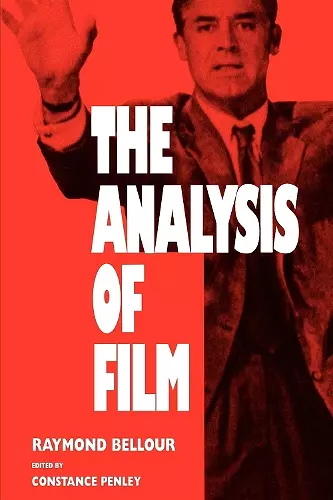The Analysis of Film
Raymond Bellour author Constance Penley editor
Format:Paperback
Publisher:Indiana University Press
Published:3rd Oct '01
Should be back in stock very soon

Bellour's classic studies of Hollywood film.
With an introductory chapter that sketches out a history of the way the close analysis of film developed, this work begins with a study of the Bodega Bay sequence of "The Birds", and then goes on to examine various aspects of that singular critical practice, 'the analysis of film'.
"No serious student of film should miss the great work collected in this volume."—W. A. Vincent, Choice
"When so much writing about film is based on overall impressions or shadowy memories, on notes scribbled in the dark or published shot breakdowns that are often overgeneralized or even inaccurate, it is refreshing to be confronted with such scholarly work, characterized by a genuinely attentive eye and a punctilious observation of detail. This long-awaited collection, gathering Bellour's ground breaking studies into one volume, will surely be a crucial source of inspiration for future generations of film scholars." —Peter Wollen, Bookforum
The Analysis of Film brings together Raymonds Bellour's now classic studies of classic Hollywood film. It is at once a book about the methods of close film analysis, the narrative structure of Hollywood film, Hitchcock's work—The Birds, Marnie, Psycho, North by Northwest—and the role of the woman in western representation. But, finally, it is a book about cinema itself and the love for cinema that drives the passion for analyzing the supreme art form of the twentieth century.
Bellour creatively reworks the ideas and methods of structuralism, semiology, and psychoanalysis to unravel the knot of significations that is the filmic text. The introductory chapter sketches out a history of the way the close analysis of film developed. And then, beginning with a study of the Bodega Bay sequence of The Birds, the book goes on to examine every aspect of that singular critical practice, "the analysis of film."
The book is also a model of how to write about the intricacies of film narrative, shot by shot, sequence by sequence, while addressing larger contextual issues of subjectivity, desire, and identification in Western cultural forms. A new, final chapter on D. W. Griffith's The Lonedale Operator brilliantly demonstrates that the dynamics of repetition and alternation that Bellour discovered to be the heartbeat of Hollywood narrative film were already there in nascent form at the beginnings of cinema.
Written between 1969 and 1990, the essays in this collection remind the reader of what a brilliant film analyst Bellour was. Building on the work of Lacan, Metz, and Thierry Kuntzel, Bellour developed his own approach to analysis based primarily on a shot-by-shot study. This method enabled him to come as close as possible to surmounting what he perceived as the greatest difficulty in analyzing films—how to capture the moving image in words. Most of the essays here deal with Hitchcock films—The Birds, Psycho, Marnie, and North by Northwest. The last shows Bellour at his magisterial best: he couples a carefully worked out Oedipal interpretation of the plot with a close reading of the crop—duster sequence. The result is one of the best pieces ever written on Hitchcock. The other Hitchcock essays are also superb. The editor included pieces on other films—The Big Sleep, Gigi, The Lonedale Operator—but it is for the Hitchcock analyses that this book will be most valued. No serious student of film should miss the great work collected in this volume.
-- W. A. Vincent * ChoiISBN: 9780253213648
Dimensions: unknown
Weight: 476g
328 pages